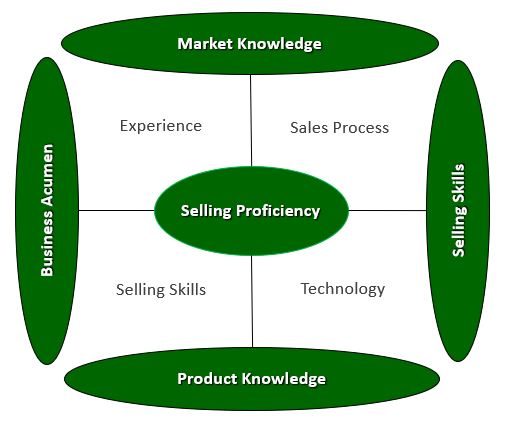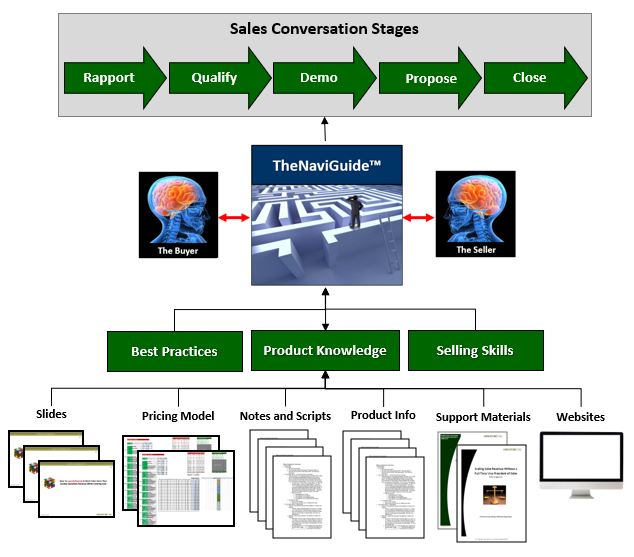TheNaviGuide™ For Sales
TheNaviGuide™ Equips Salespeople To Master Technical Knowledge In Days, Not Years.
Executing sales conversations with precision – – effectively, efficiently and predictably – – requires knowledge of and instant access to the most current:
- Market Knowledge about industries, customers and competitors.
- Product/Service Knowledge about products, services, applications and use cases, and pricing models.
- Company Knowledge about policies, procedures, work management software, administrative tasks, company history and strategic plans.
- Business Acumen about financials, the economy, world events, and their cause-and-effect.
- Selling Skills including relationship building, buyer needs investigation, story telling, objection handling, and negotiating and closing deals.
- Sales Process Knowledge including new customer acquisition, onboarding, contract renewals and upselling, cross-selling and winning back customers.
- Technology including productivity, phone systems, lead management, CRM and ERP systems.
How effective, efficient and predictable are you at transferring the right knowledge at the right time to salespeople at each stage of the employee life cycle?
What Would Happen To Productive Selling Time and Revenue Growth If…

- Buyers used fewer and shorter sales conversations to make a purchase decision?
- Underperforming Salespeople became top performers in days, not months?
- New Salespeople started selling and generating opportunities immediately when hired?
- Seasoned Salespeople started cross-selling and closing deals with new products and services in hours, not months?
- Product Managers spent less time training salespeople with fewer disruptions to answer repeat questions?
- Sales Enablement spent less time customizing, organizing and disseminating product, sales and marketing information?
What Impact Does TheNaviGuide™ Have?
Before Sales Conversations by:
- Shortening training time for new salespeople i.e. from months to days
- Reducing distractions from new salespeople asking questions as they learn the offering, applications, and pricing model
- Providing more detailed training on the nuances of products and services
- Shortening sales call preparation time…so salespeople can make more sales calls
- Producing higher quality and more uniform sales presentations without wasted time by salespeople and staff
During Sales Conversations by:
- Shortening the time needed to prioritize buyer needs, qualify them, demonstrate solutions and present proposals
- Reducing the length and number of sales calls required to reach an agreement
- Providing more appropriate and accurate explanations, i.e. giving the right explanation at the right time
- Holding more conversations that result in sales
- Experiencing less confusion and fewer expressions of unproductive negative emotions during sales calls
After Sales Conversations by:
- Shortening the time needed for follow-up activities
- Recording sales call history notes and outcomes more accurately
- Generating a greater number of creative ideas for sales call process improvement
- Improving the sharing of sales call best practices
TheNaviGuide™ Platform Simultaneously Equips Salespeople To…
Learn Technical Knowledge and Skills In Days Not Years

- New Salespeople will start selling and generating opportunities without stopping to learn technical knowledge and your sales approach.
- Product Managers will spend less time training salespeople with fewer disruptions and repeat questions from salespeople.
Prepare Their Sales Approach In Minutes Not Days

- Salespeople will sell updates to existing offerings and learn new offerings without without stopping to learn technical knowledge and adapt their sales approach.
- Sales Enablement will spend less time customizing, organizing and disseminating product, sales and marketing information.
Facilitate Fewer Sales Conversations To Close Sales

- Buyers will use fewer and shorter sales conversations to exchange information and make a purchase decision.
- Poor Performing Salespeople will increase the probability of becoming top performers without stopping to refresh technical knowledge and their sales approach.
The NaviGuide™ Is Used To Facilitate All Stages of A Sales Conversation
- Opening The Sales Conversation in a manner that builds instant credibility with the buyer without wasting time on a capability’s presentation.
- Needs Investigation in a manner that enables the seller to listen and the buyer to articulate their situation, prioritize problems, define impact of the problem, and establish financial and non-financial reasons to solve their problem.
- Demonstrating and explaining product and service features, benefits and functionality without over talking.
- Making Competitor Comparisons including features and functions, productivity, risk and cost analyses.
- Calculating Pricing and Presenting Proposals to buyers “live-time” during the sales conversation.
- Handling Objections without losing control of the sales conversation.
- Closing the conversation in a way that cements the deal while taking the first steps to up-sell and cross-sell.
TheNaviGuide™ Equips Salespeople To Keep Selling While Preparing Their Sales Approach.
TheNaviGuide™ equips salespeople to facilitate the exchange of information between the buyer and the seller during sales conversations. So, they have everything they need to deliver the right knowledge, information and skills at the right time during sales conversations. It does this by:
- Mapping The Buyers Decision Tree to anticipate, organize, and display the most precise conversation sequence. This includes questions, answer options, explanations, demonstrations, recommendations, comparisons, proposals, negotiations, objection handling, and closing.
- Visually Presenting the right questions, answer options, and explanations at the right time during the exchange of information. This increases the accuracy of what’s discussed while minimizing confusion and the need for verbal explanations.
- Equipping Buyers to prioritize conversation topics based on their situation, problems and needs.
- Providing “One-Click” Access to information and documents needed by the buyer and seller to complete the exchange of information. This minimized interruptions and the need to prematurely end a sales conversation to find information.
- Using “Plain English” and Simple Visuals to minimize misinterpretations and the need to ask clarifying questions.
- Embedding Application of Selling Skills and Best Practices. This extracted ROI from previous investments in sales training. It also enabled uniform application from sales conversation-to-conversation and sales person-to-person.
- Automatically Distribute Real-Time Updates of technical information, selling skills, and best practices. to ensure use of the most current information, skills, and practices.
- Eliminating the need for multiple sales presentations, scripts and documents. This reduced confusion about what documents to use and eliminated the need to create new slides and presentations.
TheNaviGuide™ enables sales conversations to be executed with precision – – effectively, efficiently and predictably – – from sales conversation-to-sales conversation and from salesperson-to-salesperson.
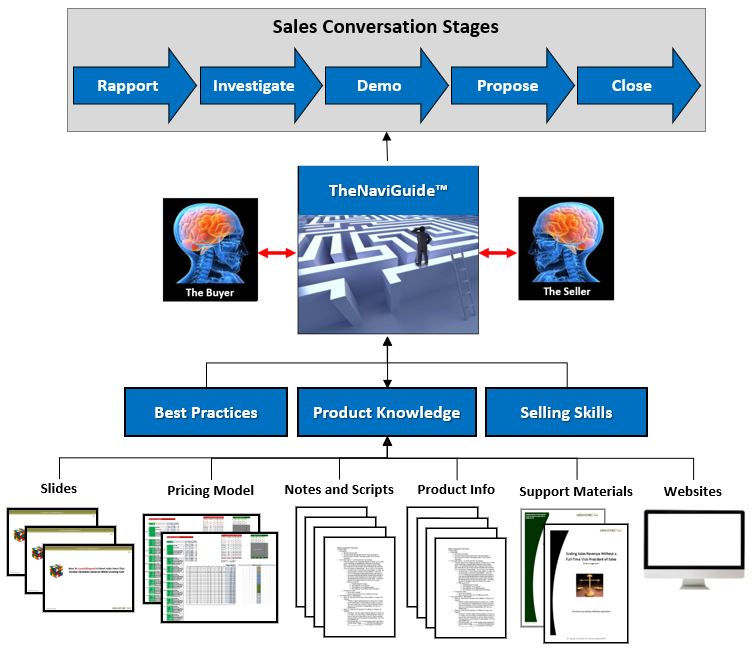
What Causes Salespeople To Stop Selling?
Complex conversations require executives, managers. and employees to:
- Learn technical information, knowledge and skills by reading, note taking, memorizing.
- Prepare questions, answers, presentations, and support documents; and rehearsing.
- Facilitate the exchange of information by sequencing questions, recalling answers, accessing documents.
The problem becomes exponential as you increase complexity including the number of product categories, pricing models, industries, geographies, and buy points served, etc..
It also creates inconsistent application of knowledge and skills from sales conversation-to-sales conversation and salesperson-to-salesperson.
So, how are you equipping salespeople to simultaneously learn complex information, prepare their sales approach, and facilitate the exchange of information with buyers – – without causing them to stop selling?
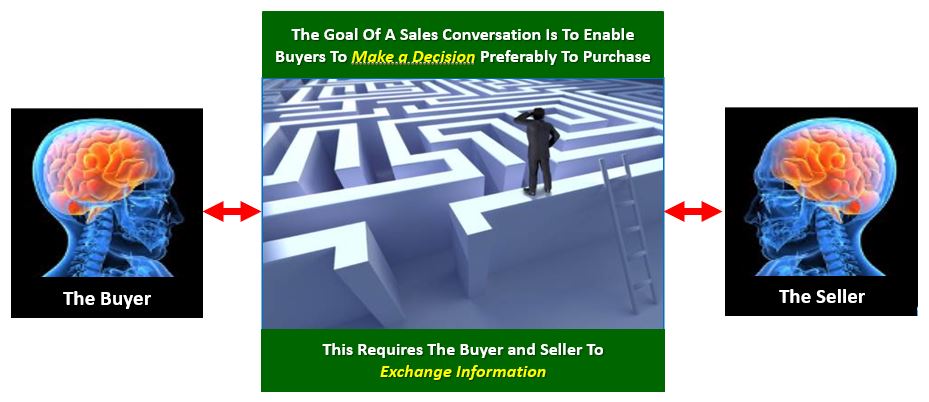
In simple terms, traditional learning approaches deliver knowledge and skills through an internal focus on:
- Knowledge Management Systems which collects, categorizes and stores documents in sales playbooks, FAQs, webpages, Wiki’s and online shared folder like One Drive, Google Drive, and DropBox.
- Training Programs which impart knowledge through learning management systems including self-paced, webinar and in-person events.
- Updates which document changes and modifications to product, marketing, sales, competitor and other information delivered through emails and online.
This forces salespeople to stop selling to review, take notes, memorize, message experts, attend training, and study. The problem becomes exponential as you increase the number of product categories, pricing models, industries, geographies, and buy points served.
It also creates inconsistent application of knowledge and skills from sales conversation-to-sales conversation and salesperson-to-salesperson.
How effective, efficient and predictable are you at transferring the right knowledge at the right time to salespeople “live time” during sales conversations?
If your salespeople are doing one or more of the following things during sales conversations then it’s time to assess your approach.
- Jumping from topic-to-topic and point-to-point.
- Over-explaining (talking too much) or under explain things.
- Forgetting what to say and not to say.
- Prematurely ending sales conversations to find answers.
- Over or understating company capabilities.
- Using jargon, buzzwords, and language that confuses buyers.
- Becoming confused when buyers change the subject.
- Paying limited attention to what buyers are saying.
- Frequently losing their place in conversations with buyers.
- Using sales presentations that confuse buyers.
What Impact Does TheNaviGuide™ Have?
- Shortening training time for new salespeople i.e. from months to days
- Reducing distractions from new salespeople asking questions as they learn the offering, applications, and pricing model
- Providing more detailed training on the nuances of products and services
- Shortening sales call preparation time…so salespeople can make more sales calls
- Producing higher quality and more uniform sales presentations without wasted time by salespeople and staff
- Shortening the time needed to prioritize buyer needs, qualify them, demonstrate solutions and present proposals
- Reducing the length and number of sales calls required to reach an agreement
- Providing more appropriate and accurate explanations, i.e. giving the right explanation at the right time
- Holding more conversations that result in sales
- Experiencing less confusion and fewer expressions of unproductive negative emotions during sales calls
- Shortening the time needed for follow-up activities
- Recording sales call history notes and outcomes more accurately
- Generating a greater number of creative ideas for sales call process improvement
- Improving the sharing of sales call best practices

Have Traditional Sales Improvement Solutions Failed?
- Staffing – replacing under-performing salespeople and managers.
- Motivation – changing your sales compensation plan and reward system.
- Sales Training – to improve selling skills.
- Messaging – developing a new sales pitch.
- Sales Collateral – creating new brochures, product sheets, web landing pages.
- Coaching – reviewing call recordings, attend field sales meetings.
- Content – crafting new sales presentations, scripts, Wiki, FAQ sheets.
- Procedures – building a sales playbook.
- Refresher Training – on products, applications, pricing, competitors, selling skills
- Software – changing your CRM system, sales library, auto-dialer
TheNaviGuide™ Proposal Builder
- Speeds training of new and existing salespeople
- Provides coaching tips on how to use the slide
- Shares specific goal(s) for the conversation at that moment in time
- Offer tips on keywords and phrases to use and to avoid using
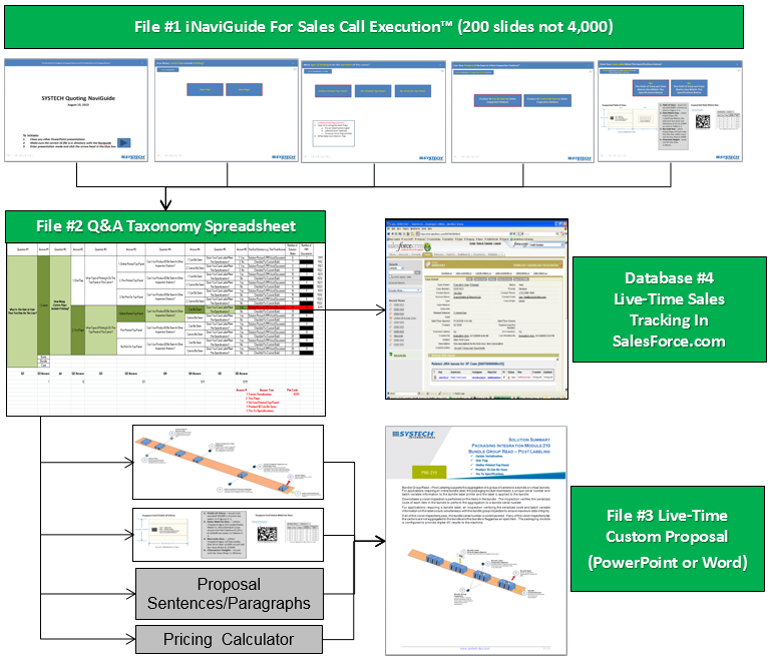

TheNaviGuide™ Conversation Tracking
Can automatically document choices made by buyers during the exchange of information to:
- More consistently record history notes and next steps
- Reduce the time required to record buyer requirements and build proposals
- More accurately track sales opportunities
- Reduce time gathering data for account planning
- Enable sales calls to be used as qualitative market research
- Instantly prepare proposals and pricing calculations
The NaviGuide™ Is Used To Facilitate All Stages of A Sales Conversation Including:
- Opening The Sales Conversation in a manner that builds instant credibility with the buyer without wasting time on a capability’s presentation.
- Needs Investigation in a manner that enables the seller to listen and the buyer to articulate their situation, prioritize problems, define impact of the problem, and establish financial and non-financial reasons to solve their problem.
-
Demonstrating and explaining product and service features, benefits and functionality without over talking.
-
Making Competitor Comparisons including features and functions, productivity, risk and cost analyses.
-
Calculating Pricing and Presenting Proposals to buyers “live-time” during the sales conversation.
-
Handling Objections without losing control of the sales conversation.
-
Closing the conversation in a way that cements the deal while taking the first steps to up-sell and cross-sell.
TheNaviGuide™ Works By…
- Using a decision tree to anticipate, organize, and map the most precise conversation sequence. This includes all questions, answer options, explanations, demonstrations, recommendations, comparisons, proposals, negotiations, objection handling, and closing.
- Visually presenting the right questions and answer options at the right time during the exchange of information.
- Equipping buyers to prioritize conversation topics based on their situation and problems.
- Providing “one-click” access to information needed by the buyer and seller to complete the exchange of information.
- Using plain English and simple visuals to minimize misinterpretations and the need to ask clarifying questions.
- Embedding application of selling skills and best practices to extract ROI from previous investments in sales training and ensures uniform application from sales conversation-to-conversation and sales person-to-person.
- Distributing real-time updates of technical information, selling skills, and best practices.
- Eliminating the need for multiple sales presentations, scripts and documents.

